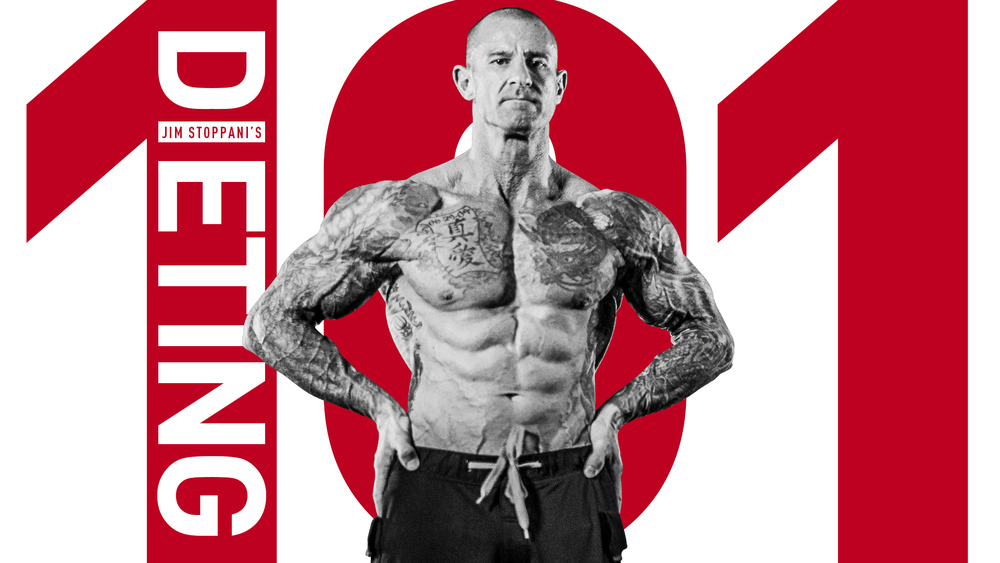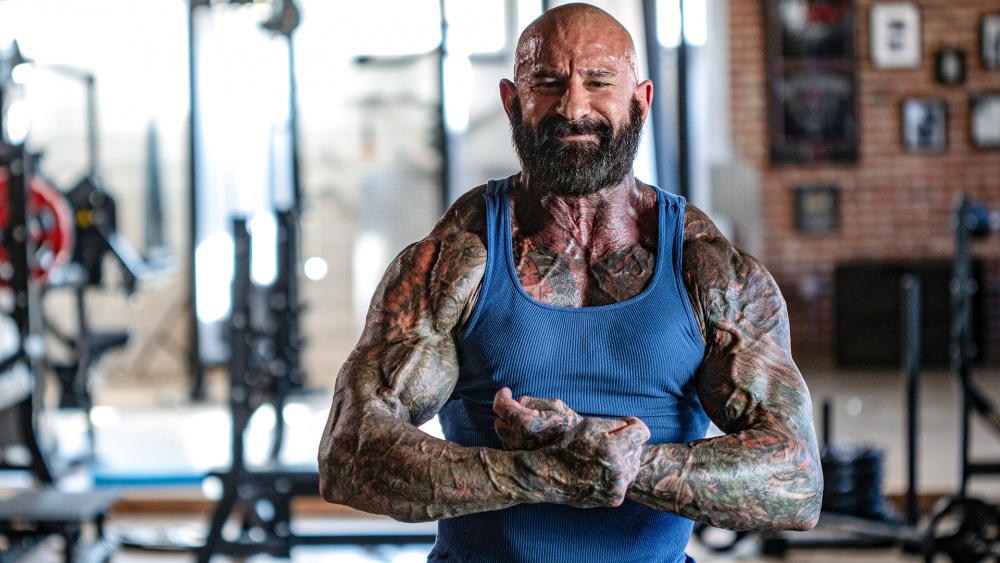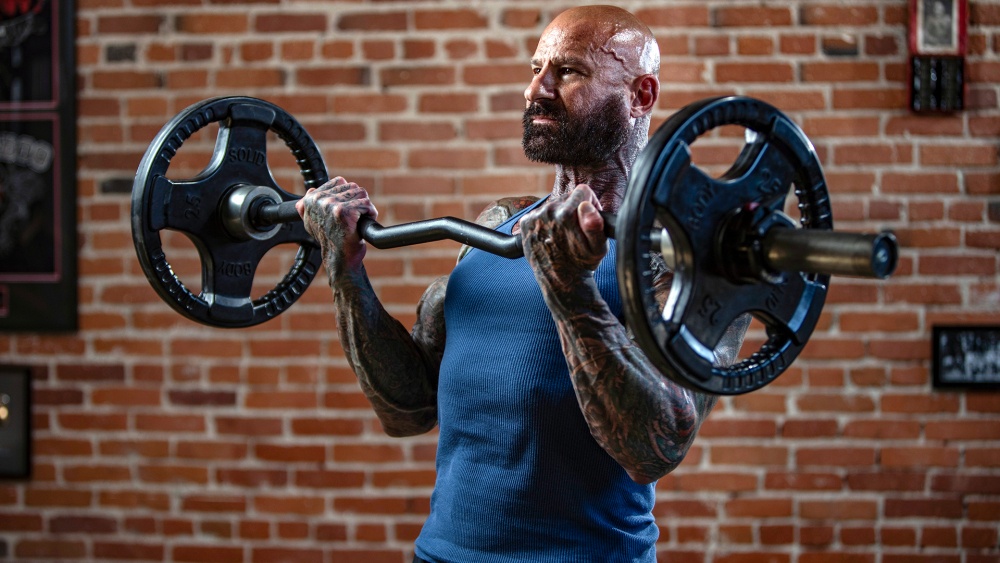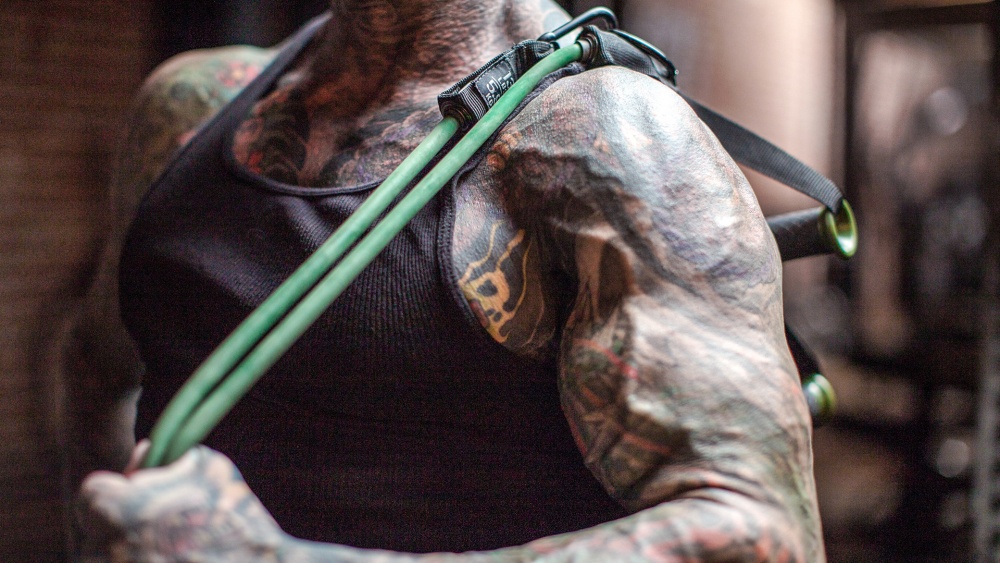Lat Pulldown Instructional video
Lat Pulldown Variation Video
Note: The above videos were recorded as Facebook Live tutorials in conjunction with the Train With Jim Super-Man Remastered (Video #1) and Full-Body Shortcut to Size (Video #2) programs.
How to Do a Lat Pulldown
- Wide-grip lat pulldowns are one of the best exercises you can do for building a wider back. It’s basically the same movement as a wide-grip pull-up, but because it’s a machine exercise (not a bodyweight move), you have the ability to better manipulate load and rep ranges.
- Body angle (staying vertical), grip, and scapular position are all important aspects of the pulldown to ensure maximum overload on the lats; wrist straps are also very helpful with pulldowns for overloading the lats.
- To isolate each lat individually, one-arm lat pulldowns are a great addition to any back-training program.
- Behind-the-neck lat pulldowns can also be used to emphasize upper lat development, but proper technique is paramount to minimize the risk of injury to the neck and shoulders.
If you want to build a bigger, wider back to achieve that desirable “V-taper” physique, lat pulldowns should show up regularly in your training program. There are many different variations of the movement, but when I use the broad term “lat pulldown,” I’m referring to wide-grip (overhand) pulldowns, as opposed to close-grip or reverse-grip pulldowns.
It may seem like a simple exercise, but there are many technical cues to consider with this move – otherwise, you’ll be emphasizing a lot of muscles other than the lats when doing pulldowns. I cover these cues in this installment of my Master Class series.
Anatomy of the Lat Pulldown
The main movers involved when doing lat pulldowns are the huge latissimus dorsi muscles of the back – the “lats.” But pulldowns also target a muscle called the teres major that sits up high on the back and is considered a part of the upper lats. Even though it's not a lat muscle per se, the teres major provides that width at the very top of your back, right under your armpits.
Anatomy and biomechanics are always closely related when we talk about different resistance-training exercises. And to illustrate the key biomechanical elements of the lat pulldown, I’ll compare the movement to a couple other common back exercises (namely, pull-ups and rows), as well as other pulldown variations.
Pulldowns vs. Pull-Ups
I want to compare these two exercises because they’re both major movements for the back/lats and entail similar paths of motion. The main difference between the two is this: pull-ups are a closed-chain exercise and lat pulldowns are an open-chained move.
Most people aren’t familiar with these terms, but it’s pretty simple: With the closed-chain movement (pull-ups), your hands are stationary on the pull-up bar and your body is moving up and down. With the open-chain exercise (pulldowns), it’s the opposite – your body is stationary and your hands are moving. Basically the same movement patterns, just different types of exercises.
And what are the benefits of doing the open-chain exercise in this case? The more appropriate question here should actually be: What’s the limitation of the closed-chain move? With pull-ups, it’s pretty obvious. Not everyone can do a high number of reps, if any, on bodyweight pull-ups. So, there are strength limitations. Your bodyweight is your bodyweight, and it's hard to reduce that in the middle of a workout unless you have an assisted pull-up machine or elastic bands. If one of my workouts calls for 20 reps per exercise, but you can only do 5 pull-ups, it won’t work.
With pulldowns, however, you get to adjust the weight. By simply moving the pin up or down on the machine, you can go light and do high reps or go heavy for low reps. I typically use pulldowns as the main lat exercise in programs versus pull-ups, because I like to manipulate weight and hit specific rep ranges.
Don’t get me wrong. I’m not saying lat pulldowns are a better exercise than pull-ups. Both moves are phenomenal back exercises. I’m just saying that pulldowns are more versatile and accommodate a much wider range of rep counts.
Pulldowns vs. Rows
Whereas pulldowns and pull-ups are essentially the same motion, there’s another major back exercise – the row – that follows a much different path.
A row is essentially a perpendicular move; your arms are perpendicular to your body, and you're pulling the weight in toward your midsection. With a pulldown, your arms are straight overhead and you're pulling the weight downward.
When you're doing a row, yes, the lats and teres major are involved; however, you get more involvement from other muscle groups like the middle traps, the rhomboids, and the rotator cuff. Below, I’m going to discuss what to do with your scapula while doing pulldowns so that you focus on keeping the movement vertical instead of horizontal. The more horizontal it is, the more similar it is to a rowing motion. That’s not what we want. Save the rowing motion for actual row exercises!
Variations: Wide-Grip, Close-Grip, Reverse-Grip, and Neutral-Grip Pulldowns
As I’ve said, wide-grip pulldowns focus mostly on the upper lats (including the teres major). The reason for this is, again, biomechanics. With the wider grip, when you do the pulldown, the elbows flare out, and this directs the focus up high in the lats.
In this picture of a standard wide-grip lat pulldown (where I’m at a midpoint during the rep), you can see that my elbows are flaring out:

Other common pulldown variations are close-grip (narrow), reverse-grip, and neutral-grip (palms facing each other using a cable row attachment). If you do my programs, you know that I prescribe reverse-grip pulldowns a lot. With all three of these variations, the elbows stay in front of the body instead of flaring out. This directs more focus onto the lower portion of the lats.
In this photo of the close-grip pulldown (again, at the midpoint of a rep), you can see that my arms are in front of my body and my elbows are pointing pretty much forward.
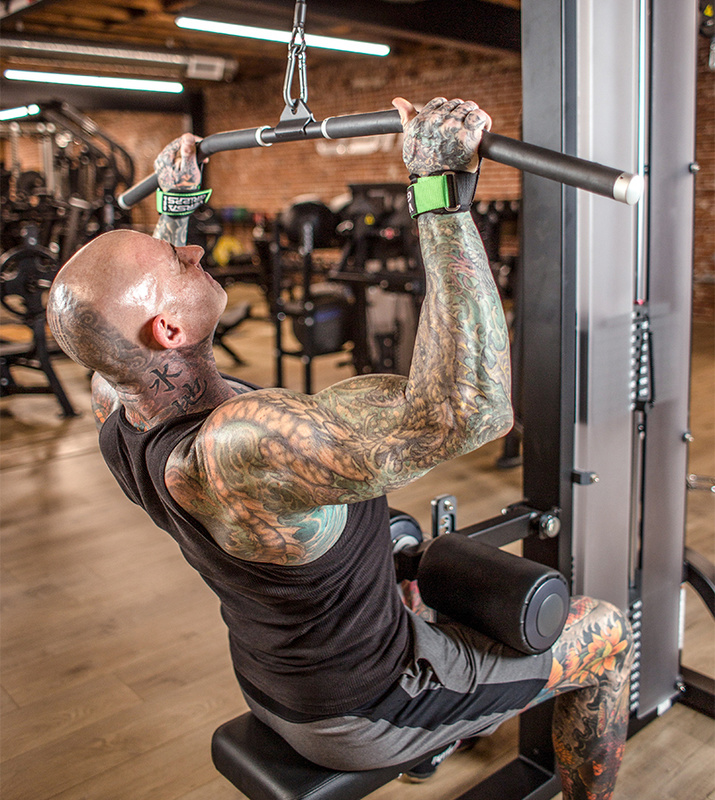
So which grip should you use on pulldowns? All of them! Variety is the key to maximizing development in a given muscle group (the back, in this case). That said, choose your variations based on which areas of the back you want to focus on in a given workout, or a given phase of your training.
If you lack width in the upper back and really want to try to improve in that area, do most of your pulldown sets with a wide grip; personally, I like to go extra wide on pulldowns, where my hands are at the very ends of the bar.
If width isn’t a problem for you, but you want your lats to be more pronounced in the bottom area of the muscle, focus more on reverse-grip, close-grip, and neutral-grip pulldowns.
If you don’t have a specific concern one way or the other when it comes to your lat development, I recommend more or less equal doses of all variations. But from my experience, I’ve found that most people want to increase the width of their backs. Because of that, I generally prescribe more wide-grip pulldowns than narrow or reverse-grip.
Lat Pulldown Instructions
- Grab a lat pulldown bar with an overhand grip outside of shoulder width and sit on the seat with your knees secured underneath the pads. Begin with your arms extended overhead and your torso erect.
- Leading with your elbows, pull the bar down until your upper arms reach at least parallel with the floor.
- Squeeze your shoulder blades together for a count at the bottom, then slowly return the bar to the start position.

How to Do the Lat Pulldown
Setup
When it comes to getting in proper position for a lat pulldown, at the start of each set you need to consider how you’re sitting on the machine, what type of grip to take, and how to put your shoulder joints (specifically your shoulder blades) in the best spot for maximal lat involvement. Here are the key points for achieving all of this:
Stay Vertical
When you get into the lat pulldown station, you want to make sure your body is as vertical as possible with the line of pull of the movement (going up and down). Achieving this is all about getting into the right seated position from the start.
Lat pulldown machines can vary by manufacturer, but generally speaking, what you don’t want to do is sit too far forward on the seat. This is a very common mistake people make. Look what happens when you’re too far forward; specifically, look where the pulley is in relation to my head. If I pull the bar straight down, it’s going to hit the top of my head.
Of course, what you tend to do in this case is simply lean back so that the bar doesn’t hit your head. But when you do that, you’re moving out of the vertical plane and putting your arms more perpendicular with your torso. Essentially what you’re doing is making the movement more like a row, when the whole point of the exercise is to keep it vertical. If you want to do a rowing movement, fine, do rows. But if you’re doing pulldowns, make sure the pull is vertical.
Here’s what a lat pulldown looks like when you lean back. Looks like a row, right?

So, instead of sitting directly under the bar, where it would come down on your head if you stayed vertical, what you’re going to do is sit back. Lower the knee pads, put your knees (not your thighs) under the pads, and sit with your butt way back on the pad.
Now, watch the difference with this body position and the line of pull. I can keep my body more vertical and pull the bar all the way down to my chest.

And that's the goal: to maximize the vertical component. You want to keep your body as upright as possible. Sure, it’s fine to rock a bit as the reps get heavier and you fatigue later on. But in your earlier pulldown sets, you want to try to keep your body as vertical as possible without leaning back.
Grip Width
If you want to focus on building a wider back, taking a wide grip on pulldowns is your best bet – specifically, wider than shoulder-width, with an overhand grip (palms facing forward). The wider you go, the more the elbows flare out to the sides and the more upper lat and teres major involvement you’ll have.
If you want to build more width in the lower part of the lats, as well as more thickness overall in the back, you’ll want to do more close-grip or even reverse-grip pulldowns. With these versions, the elbows move to the front of the body and go from front to back as you pull down. The reverse-grip is just flipping the hands around so that your palms face in toward you, but the elbow motion is still the same – only that with the reverse-grip it’s a bit of a stronger pulldown because you have more biceps involvement, so you can use more weight.
My overall stance on lat pulldown grip width is that you should do a fair variety of all major versions: wide, narrow (close), and reverse. And you can even use a neutral-grip as well, where the palms face each other. With these, it’s going to be the same concept of bringing the elbows to the front, and again, it's more about those lower lats.
Open Grip
With pulldowns, I always recommend using an open grip – meaning, the thumbs are on the same side of the bar as your fingers, not wrapped around the bar (closed grip) as you’d naturally grab something.
Why do I NOT recommend a closed grip? A couple of reasons: First of all, when you use an open grip you tend to squeeze the bar during the exercise. When you do that, you initiate the pull from the arms, because you’re squeezing instead of focusing on your lats.
Taking an open grip helps reduce that squeeze from your hands. Now, your hands act as “hooks” – their only purpose in the exercise is to connect your arms to the bar so that you can use those huge lat muscles to perform the movement.
The other thing the open grip allows for is a stronger contraction of the brachioradialis muscle, which runs along the top of the forearm and is used to bend the elbow when using an overhand grip (as with standard lat pulldowns). When you use a reverse (underhand) grip, the brachioradialis is no longer in a strong biomechanical position, and that’s why the biceps take over. That’s also why you’re able to use more weight on reverse-grip pulldowns versus wide-grip (overhand) pulldowns.
As I explain in detail in the above Lat Pulldown Video #2, using a closed grip actually makes the brachioradialis a weaker mover on lat pulldowns. And no, this isn’t a forearm exercise, but it’s not like you can completely take the brachioradialis out of the movement; it still has to help bend the elbows and help the lats. If you put it into a biomechanically weaker position, you limit how much weight you can use on pulldowns. The less weight you use, the less overload you’re going to be able to place on the lats, and thus lessen your potential for size and strength gains.
Long story short, use an open grip!
Squeeze the Shoulder Blades
Before you start the pulldown movement, focus on squeezing your shoulder blades (scapulae) together and down. This is important for supporting the shoulder joints, and this is actually something you should be doing on other overhead exercises like shoulder presses and pull-ups, and even on bench press.
To make sure you’re doing this, when you’re about to start the movement think about sticking your chest out. Because your arms are overhead, your chest won’t really “stick out” much, but that’s what you should be trying to do. Feel your shoulder blades shift back and down slightly – lock into that position. When you do this, you’ll be able to initiate the pull from the lats, not the arms, and that’s going to maximize lat development.
Execution
The path of motion on a lat pulldown may seem pretty simple, but people get it wrong all the time. Where to pull the bar down to and how low to go (all the way to chest or stop short?) are two key things to consider.
Where to Pull?
You’ll see photos sometimes of people doing pulldowns where the bar is being pulled down way in front of the body, almost as if they’re trying to pull the bar down to their lower pecs or upper abs. This is NOT the path of motion you want. I demonstrate this poor form at around the 11:20 mark in Lat Pulldown video #1.
What you want is for the bar to be in closer to you, almost as if you’re pulling it down to your chin. Of course, you don’t want the bar to smack your chin, so make sure it’s not in the way. Instead of pulling the bar down to the meat of your chest (or lower), focus on pulling it down to your collarbones.
Like this:

How Low to Go?
One question I get a lot when it comes to lat pulldowns (particular wide-grip overhand pulldowns) is, “How low do I have to bring the bar down? All the way to my chest?”
You might expect me to say that you need to achieve a full of motion by touching the bar to your chest on every rep. But if you’re doing wide-grip pulldowns with the intent of developing more width in the upper back (lats and teres major), you actually don’t need to come all the way down to the chest.
On pulldowns, your sticking point is basically the same place as it is on bench press: When the bar is on close to your body. On bench press, this is the beginning of the rep; on pulldowns, it’s the end. But either way, that’s where you’re weakest, and that’s why it’s always hard with heavy weight and a wide grip to get that bar all the way to your chest on pulldowns.
But you really don’t need to pull all the way down. Reason being, the early part of the pull (where the bar is further away from your chest) is where your upper lats and teres major are most involved in the movement; that last part of the rep, once your arms get below parallel with the floor, is where the lower lats begin to really kick in. So if you stop at that point instead of getting all the way to your chest, you’re still hitting those upper lats sufficiently. Because of this, it’s perfectly fine to not come all the way down.
However, this is why I recommend incorporating close-grip and reverse-grip pulldowns on a regular basis in your back training – to make sure you’re hitting those lower lat fibers, too, for balanced development. With these variations, you definitely want to pull the bar all the way to your chest.
Use Wrist Straps
I’m a big proponent of using wrist straps on lat pulldowns to target the lats, not grip strength. My grip strength is plenty strong, and I train my grip separately from back. Don't limit your back development due to your grip strength. If you're ending your sets on pulldowns when your grip gives out, you’re not taking your lats to full muscle failure.
I actually conducted a study years back where I had trained lifters do a full back workout using their 10RM weights on pulldowns, rows, and a couple other back exercises. What we found was that the subjects were able to complete at least one or two more reps on every single set from the get-go, starting with set #1. So, if you think wrist wraps are only useful when your forearms and grip strength are fatigued, wrong. You’re stronger on back exercises right off the bat when using wrist straps. They also allow you to focus more on the lats (and less on gripping and pulling with the arms) and using the hands as hooks – in other words, straps can really help your mind-muscle connection, which research shows can help you build more muscle.
I use a pair of straps called Versa Gripps. These are my favorite straps, but you can use the old school canvas ones if you like.
One-Arm Lat Pulldown
Another effective lat pulldown variation is the one-arm pulldown, using a stirrup handle (aka, D-handle) on the machine. (In Lat Pulldown video #1, I go over this starting at the 16:00 mark.) You don’t see many people doing this version in the gym, but it’s really good for overloading each lat individually for more strength and size, and evening out any imbalances between the right and left.
The key with one-arm pulldowns is how you sit on the seat of pulldown station. The line of pull isn’t ideal when facing forward with your knees secured under the pads, so what I like to do is sit “side saddle.” Granted, you don’t have anything holding you down this way, but you really don’t need it, since you’re going much lighter with one arm.
Here’s what side saddle looks like:

In this shot, I’m pulling with the arm closer to the machine. But for a greater stretch in the lat, you can pull with the outside arm as well.
For an example of how to use the one-arm lat pulldown in your training, check out my 15-Minute Back Workout, which includes all one-arm back exercises.
Behind-the-Neck Pulldowns
People ask me all the time about behind-the-neck lat pulldowns, wanting to know if it’s worth doing and is safe on the shoulders.
As with shoulder presses, when you bring the bar behind the neck you’re bringing in more external rotation of the shoulders. Many people consider this dangerous for those joints, and even the neck, but a lot bodybuilders swear by behind-the-neck pulldowns for maximizing lat width – and there’s actually some EMG data showing that this version hits more of the upper lat fibers than standard lat pulldowns.
So is this version dangerous on the shoulders and neck? Not if you do it correctly!
To keep behind-the-neck pulldowns safe, first consider where the pulley is above you in relation to your body. For this version, you want to make sure that’s it’s behind you. So when you’re sitting in the seat and the bar is dangling overhead, it should be dangling just behind your head.
Just one problem with this: When you sit facing forward on the pulldown machine, the bar is dangling in front of you, which means you have to pull your head down and excessively flex your neck in order to pull the bar down behind your head. Dropping your chin like this is the LAST thing you want to do – NOT good for the cervical spine.
So what you want to do is face away from the machine for behind-the-neck pulldowns. This way, the bar starts behind your head in the first place, with no neck flexion required to get it behind your head. If doing this still has the bar in front of you, you can pull a bench over and place it in front of the seat to give you more room to move forward. You also want to take a very wide grip on the bar to hit those upper lat fibers and teres major.

Also, notice that I’m not pulling the bar down all the way to my neck; it’s actually stopping pretty high up on my head, above my ears. Why? Because first of all, I don’t need to go any lower to hit my upper lats and teres major. But more importantly, the lower I go, the more external rotation I’m getting at the shoulders – and that’s when the movement gets unsafe for the shoulder joints.
Stop at about eye level (behind your head, of course), no further down. Do this and you’ll hit those upper lats while keeping the exercise safe for both your shoulders and neck.
Lat Pulldown in Action
Find this exercise on Day 1 (chest/back/shoulders/ traps focus workout) of all four weeks of Super-Man Remastered and Day 2 (all weeks) of Full-Body Shortcut to Size, not to mention MANY other programs here on JimStoppani.com.
Enhancing Lat Activation During the Lat Pulldown
Follow these steps to build a bigger back for a more impressive V taper
Are you frustrated with your back not growing as much as you'd like, despite constantly piling on more weight during your lat pulldown exercises? Here’s a valuable tip to address this issue. In this article, I’ll offer advice on enhancing lat activation during the lat pulldown for a bigger, more impressive back.
The Common Mistake
When it comes to lat pulldowns, the mistake most individuals make is gripping the bar with a death grip and initiating the pull with their arms. While this approach might allow you to lift heavier weights, it often robs your lats of the focus they need to grow. In essence, it turns the lat pulldown into an arm exercise, rather than targeting the back muscles effectively.
How to Build a Bigger Back in 4 Easy Steps
Here’s what I recommend to maximize lat activation and stimulate muscle growth in your back:
1. Open Grip: Start by using an open grip on the lat pulldown bar, where your thumb is on the same side as your fingers, not wrapped underneath. This grip style discourages squeezing the bar and using your arms excessively during the movement.
2. Proper Form: Initiate the lat pulldown by pulling your shoulder blades back and down while sticking your chest out and up. This action creates a posture similar to hooks, which emphasizes the lat muscles. The goal is to start the pull with the lats, and then let the arms assist.
3. Controlled Movement: Keep the entire movement slow and controlled, both during the positive (lifting) and negative (lowering) phases of the repetition. Focus on contracting the lats to pull the bar down, and then let them lengthen as you allow the bar to return to the starting position.
4. Use the Arms Only as Needed: Once you reach the point of muscular failure using strict form that prioritizes the lats, you can allow the arms to assist in squeezing out a few more reps. This approach ensures that the lats receive the primary focus during the exercise.
Back-Building Benefits
Implementing these steps on the lat pulldown provides several key benefits:
1. Enhanced Lat Activation: By concentrating on starting the movement with your lats, you ensure they receive the necessary stimulation for growth.
2. Muscle Connection: These techniques help you develop a better mind-muscle connection with your lats, making it easier to feel and target them during workouts
3. Reduced Risk of Injury: Employing proper form minimizes the risk of injury and overuse of the arm muscles, promoting long-term progress.
4. Increased Muscle Growth: By focusing on the lats, you'll spur new muscle growth, resulting in a bigger, wider back that's sure to impress.
Enhancing lat activation during the lat pulldown is a valuable addition to your back training routine. By using the recommended open grip, initiating the movement with your lats, and keeping the form controlled, you can achieve that coveted, impressive back.
Related Articles














